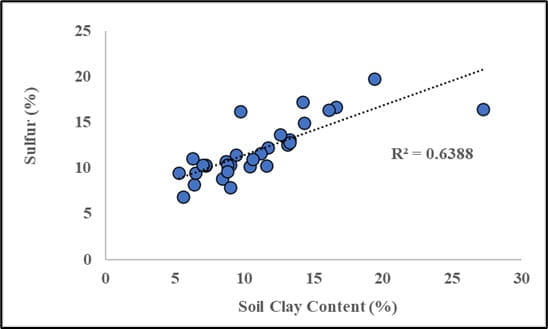Jarrod O. Miller, Extension Agronomist, jarrod@udel.edu, James Adkins, Irrigation Engineer, adkins@udel.edu
Jarrod Miller and James Adkins (funded by Maryland Grain Producers https://marylandgrain.org/)

Figure 1: Cation exchange capacity (2-8 meq/100g soil) based on ¼ acre grids at the Warrington Research Farm. Higher CEC is green.
Over four hundred soil samples were collected in 2022 for a grid sampling project at the Warrington Irrigation Research farm. Based on the range in cation exchange capacity (CEC) on the farm, 31 of the samples were analyzed for soil texture (sand, silty, clay %). Of those samples, sandy loams were the dominant texture (23 locations), followed by loamy sand (7) and one silty clay loam sample. Clay contents ranged from 5 to 27%, with an average content of 10% across the research farm.
The goal was to determine if texture could help predict some contents of nutrients as well as soil properties. Characteristics that increased with clay content (Figure 2) include CEC, organic matter (OM), potassium (K), sulfur (S), and aluminum (Al). It is well known that CEC is associated with greater clay content, as well as the ability of clay to bind and protect OM from decomposition. It is a little more difficult to determine whether the increased CEC is from clay alone, or in connection with greater soil OM. Similarly, the greater S with clay content could also be related to OM contents.




Figure 2:Clay content comparisons to CEC (yellow), organic matter (grey), potassium (light blue), and sulfur (dark blue) across the research farm.
The greater K associated with clay indicates how important higher CEC is for adequate fertility, as it probably leaches easier from lower CEC soils. It could also be related to the type of clays in the soil. Not show here are increases in Al, Mg, and B with clay, and a decrease in the soil buffer pH.
Coastal soils do not represent the entire region, and some of these relationships may be stronger due to the lower CEC found in our sandy Delmarva soils. However, this does highlight the need to understand soil variability and the effects on leaching and loss when making fertility decisions, including variable rate applications.
